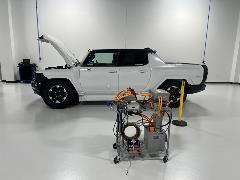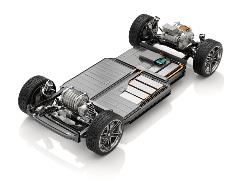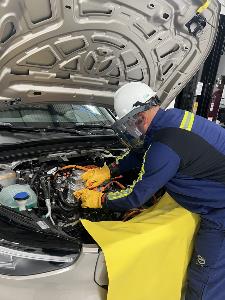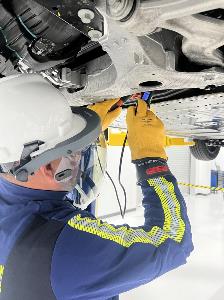Protecting EV Technicians: The Crucial Role of Electrical Hazard PPE

Electric vehicles (EVs) are reshaping the automotive landscape, introducing advanced technologies and eco-friendly alternatives to gas-powered cars. However, the high-voltage systems that power EVs also bring significant electrical hazards, which are less common in traditional vehicles.
This shift makes the need for effective electrical safety gear, particularly arc flash personal protective equipment (PPE), more crucial than ever. This article explores the booming EV market, its unique electrical safety challenges, and how modern Arc Flash PPE meets these emerging needs.
The Rising EV Market
 The surging interest in electric vehicles (EVs) in the United States mirrors a transformative shift toward sustainable transportation, influenced strongly by consumer demand for greener alternatives and significant technological advancements.
The surging interest in electric vehicles (EVs) in the United States mirrors a transformative shift toward sustainable transportation, influenced strongly by consumer demand for greener alternatives and significant technological advancements.
In 2022, the U.S. saw an impressive 55% increase in electric car sales compared to the previous year, led predominantly by Battery Electric Vehicles (BEVs). Sales of BEVs alone surged by 70%, reaching nearly 800,000 units. This remarkable growth occurred despite an 8% overall drop in total car sales, contrasting sharply with the global average decline of just 3%. Such figures highlight a decisive consumer shift towards electric options in the U.S. market.
This trend is further underscored by the increasing adoption rates, with electric vehicles now representing nearly 8% of total U.S. car sales, up significantly from just above 5% in 2021. The total stock of electric cars in the U.S. reached 3 million, accounting for 10% of the global total and marking a 40% increase from the previous year.
The U.S. is actively facilitating this shift through federal investments and tax credits that not only encourage domestic EV production but also promote broader adoption among consumers. These incentives are part of a strategic effort to position the U.S. as a leader in the global EV market, reflecting a strong commitment to environmental responsibility and technological innovation.
These policy-driven efforts boost local markets and set a global standard for environmental responsibility in the automotive sector. However, while the rise of electric vehicles marks a significant advancement towards sustainable transport, it also introduces complex safety challenges.
Electrical Safety Challenges in the EV Sector
 Electric vehicles introduce significant hazards in automotive repair and manufacturing environments due to the sophisticated nature of their design and power systems. These vehicles come with high-voltage batteries, typically ranging from 400 volts in standard models to upwards of 800 volts in high-performance options. While this high voltage is crucial for efficient power transfer and enhanced vehicle performance, it also introduces elevated risks:
Electric vehicles introduce significant hazards in automotive repair and manufacturing environments due to the sophisticated nature of their design and power systems. These vehicles come with high-voltage batteries, typically ranging from 400 volts in standard models to upwards of 800 volts in high-performance options. While this high voltage is crucial for efficient power transfer and enhanced vehicle performance, it also introduces elevated risks:
- High Voltage Components: EVs contain components and cables that carry high voltages strong enough to deliver a fatal electric shock.
- Energy Storage Risks: The batteries used to store electricity in EVs pose significant risks of explosion or fire if damaged or improperly handled.
- Retained Voltage Dangers: Even when EVs are turned off, their components can retain dangerous levels of voltage.
 Technicians at EV service centers frequently encounter these electrical hazards, leading to incidents of electric shocks and burns. Often, these injuries result from a failure to follow proper vehicle shutdown and safety procedures, underscoring the need for rigorous adherence to safety protocols.
Technicians at EV service centers frequently encounter these electrical hazards, leading to incidents of electric shocks and burns. Often, these injuries result from a failure to follow proper vehicle shutdown and safety procedures, underscoring the need for rigorous adherence to safety protocols.
In manufacturing settings, workers are regularly near the EV's high-voltage systems, including batteries and internal wiring. The constant risk of exposure to high voltages demands that safety measures be meticulously observed and that protective measures be fully integrated into daily operations.
Effectively managing these risks goes beyond safety protocols; it requires compliance with essential standards like NFPA 70E, which outlines protections against workplace electrical hazards such as arc flash and shock. Strict adherence to these standards, comprehensive training, and equipping workers with the necessary protective gear are crucial to safely prepare employees to handle the unique challenges.
The Necessity of Arc Flash PPE
Arc flashes present a significant risk in any electrical environment, particularly in the servicing and manufacturing of electric vehicles (EVs). These incidents can release large amounts of energy in the form of thermal radiation, light, and pressure waves, capable of causing severe injuries or even fatalities. To mitigate the risks of arc flashes, specific types of personal protective equipment (PPE) are required:
 Arc-Rated Garments: These garments are designed to withstand the extreme conditions of an arc flash, including intense heat and flames. They are tested to ensure they meet industry standards like ASTM F1506, which specifies the performance requirements for textiles used in clothing exposed to electrical arcs.
Arc-Rated Garments: These garments are designed to withstand the extreme conditions of an arc flash, including intense heat and flames. They are tested to ensure they meet industry standards like ASTM F1506, which specifies the performance requirements for textiles used in clothing exposed to electrical arcs.- Face Shields and Helmets: For full-face protection, technicians should wear face shields rated for high-energy arcs to prevent facial burns and eyesight damage. Helmets provide additional protection against flying debris and pressure waves.
- Shock Protection: The rescue hook is an essential piece of equipment in any environment where electrical hazards are present. Should someone be incapacitated from electrical shock, the rescue hook allows for safe rescue from a distance.
Appropriate personal protective equipment (PPE) is crucial in environments such as EV battery maintenance facilities or assembly lines, where the high voltage systems inherent to these vehicles significantly heighten electrical hazards. Given the critical need for solid arc flash protection in the EV industry, Enespro's innovative PPE kits stand out as custom-designed solutions specifically crafted to meet the unique demands of this field.
Enespro's Tailored Solutions for EV Technicians
Enespro's commitment to enhancing workplace safety in the EV sector has led to the development of specialized EV hazard protection kits that address technicians' unique challenges.
Enespro's hazard protection kits provide not just compliance with safety standards but also enhanced usability, which sets them apart in the market. Each kit is designed as a complete solution, reducing the need for technicians to source individual pieces of PPE from different suppliers. In addition, by focusing on the ergonomics of PPE, Enespro ensures that wearers are not only safe but can also perform their tasks without restriction, which is vital for productivity and job satisfaction.
In the rapidly expanding EV market, the demand for reliable and effective safety solutions like those offered by Enespro will continue to grow. By providing PPE that enhances safety, comfort, and mobility, Enespro not only meets the current industry standards but also sets new benchmarks for what protective gear can achieve.
Connect with Saf-T-Gard to Learn More
Industrial safety is our legacy going back 9 decades, and electrical safety is our specialty. For an overview of our electrical safety products and services, and automotive safety for the EV market, including National Safety Apparel, Enespro, and DRIFIRE, please visit National Safety Apparel.

